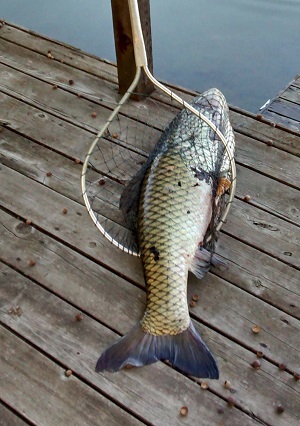 Most don’t know one carp from another. All are exotic.The photo to the left is a 30-pound-plus grass carp illegally stocked in a small lake.
Most don’t know one carp from another. All are exotic.The photo to the left is a 30-pound-plus grass carp illegally stocked in a small lake.
Common carp have been in this country for so long (more than a century) that many think they are native. They are not. They were imported by the federal government. Rooting around on the bottom, they have destroyed and degraded many fisheries.
Fish farms in the South and Mid-South imported Asian carp (bighead and silver), and they escaped into rivers, spreading throughout much of the country. Through filter feeding, they gobble up forage needed by many native species, including juvenile sport species.
Grass carp were imported to eat problematic aquatic plants, including hydrilla and Eurasian watermilfoil, also exotic species. Often they were overstocked. Sometimes. they were stocked where they were not needed. Often they were stocked illegally. And they too have escaped and spread.
To add to the confusion, Canadian media and fisheries officials frequently refer to grass carp as Asian carp.
* * * *
Although silver and bighead are the Asian carp of most concern these days for the Great Lakes and its tributaries, disturbing discoveries have been made lately regarding a third— the grass carp.
First, a graduate student at the University of Toledo found eggs in the Sandusky River, which flows into Lake Erie. That confirms the existence of a reproducing population of this fast-growing species, which doesn’t compete with native fish, but does obliterate beneficial aquatic vegetation.
Additionally, Canadian commercial fishermen recently netted a grass carp weighing more than 60 pounds from the St. Lawrence River, far above Lake Ontario.
Anthony Ricciardi, a biology professor at McGill University, doesn’t think that the river has a reproducing population, but suspects that others are in the St. Lawrence as well.
“We actually thought the Asian carp was confined,” added Quebec biologist Michel Legault. “But we know that in recent years the grass carp has been found in a small section of Lake Erie. And last summer, nine grass carp were caught in the Toronto area. This is not good news.”
On the Sandusky, meanwhile Toledo researchers intend to learn more about the grass carp spawning there, in hopes of finding a way to minimize it.
